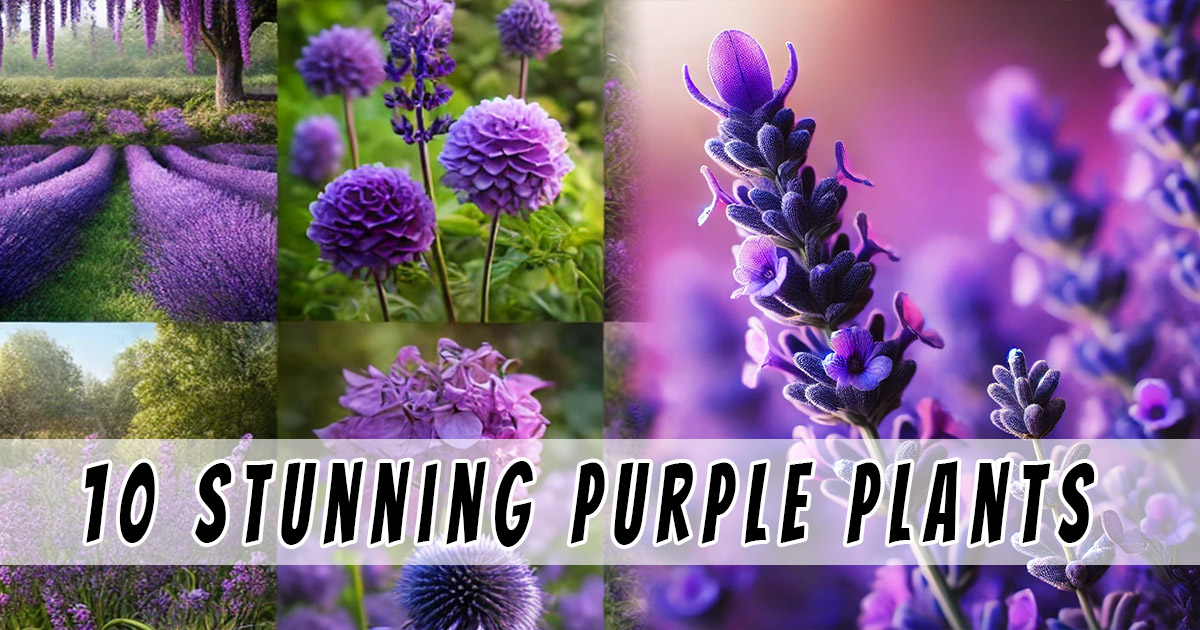Introduction
Purple plants are a fantastic way to introduce bold color and vibrancy into your garden or home. The unique shades of purple, ranging from deep violet to soft lavender, can add a sense of elegance, mystery, and serenity to any space. Whether you’re looking for purple plants with flowers, foliage, or succulents, there’s an option for every type of gardener.
In this blog, we’ll explore why purple plants are a must-have for your garden, showcase 10 stunning varieties, and provide tips on how to care for them. Whether you’re a beginner or an experienced gardener, you’ll find the perfect purple plants to add color to your space. Let’s dive into the beauty of purple plants!
1. Why Choose Purple Plants for Your Garden?
Purple is often associated with royalty, luxury, and creativity. When you incorporate purple plants into your garden, you add a touch of sophistication and intrigue. But it’s not just the visual appeal that makes purple plants special—there are several other reasons to choose them:
- Visual Contrast: Purple plant stand out beautifully against green foliage, creating a striking contrast in any garden.
- Mood Enhancer: Purple is known for its calming effects, making it ideal for spaces where you want to relax and unwind.
- Pollinator Attraction: Many purple flowering plants attract beneficial pollinators such as bees and butterflies, which helps your garden thrive.
- Versatility: Whether you want purple flowers, foliage, or even succulents, there’s a wide range of options to suit various garden styles and climates.
Choosing purple plants can transform your garden into a visually dynamic and tranquil space. Let’s look at some of the best purple plants you can grow.
2. 10 Stunning Purple Plants to Add to Your Garden
Here are ten stunning purple plants that you can add to your garden, ranging from flowering perennials to colorful foliage plants. Each offers a unique beauty and charm that will enhance your outdoor space.
1. Lavender (Lavandula)
Lavender is a classic purple-flowered plant known for its fragrant blooms and soothing properties. It’s a perennial herb that’s perfect for low-maintenance gardens. Lavender thrives in sunny, well-drained soil and can also be grown in containers.
2. Purple Coneflower (Echinacea purpurea)
The purple coneflower is a stunning perennial that produces large, daisy-like flowers with vibrant purple petals. It’s a pollinator-friendly plant that attracts butterflies and bees, making it a perfect addition to wildlife gardens.
3. Purple Heart (Tradescantia pallida)
This plant features striking purple foliage and is incredibly easy to grow. Purple Heart thrives in containers, hanging baskets, and garden beds, offering a splash of color wherever it’s placed.
4. Japanese Maple (Acer palmatum ‘Atropurpureum’)
The Japanese Maple is known for its deep burgundy-purple leaves, especially in the fall. This small tree or large shrub adds an elegant touch to any garden and is perfect for providing shade and structure.
5. Verbena (Verbena bonariensis)
Verbena is a hardy perennial with clusters of tiny purple flowers that bloom from late spring to fall. It’s great for adding height and color to borders, and its nectar-rich flowers attract a variety of pollinators.
6. Purple Shamrock (Oxalis triangularis)
This plant features triangular-shaped purple leaves that fold up at night, giving it a unique appearance. The Purple Shamrock is perfect for adding a vibrant pop of color to garden beds or containers.
7. Wisteria (Wisteria sinensis)
Wisteria is a climbing vine that produces cascading clusters of fragrant purple flowers. It’s a stunning addition to trellises, arbors, or fences, offering both height and a dramatic floral display.
8. Salvia (Salvia nemorosa ‘Caradonna’)
Salvia is a robust perennial with tall spikes of deep purple flowers. It’s drought-tolerant and low-maintenance, making it ideal for sunny spots in your garden.
9. Purple Smoke Bush (Cotinus coggygria ‘Royal Purple’)
The Purple Smoke Bush offers dark purple foliage and airy plumes of flowers that resemble puffs of smoke. It’s an excellent shrub for adding texture and color to your landscape.
10. Allium (Allium giganteum)
Alliums are known for their round, globe-like clusters of tiny purple flowers. They bloom in late spring and are great for adding architectural interest to your garden.
These best purple plants bring a variety of textures, colors, and fragrances to your garden, creating a captivating display all year long.
3. The Best Purple Indoor Plants for Every Space
If you’re looking to add a touch of purple to your indoor space, there are several purple indoor plants that not only look beautiful but are also easy to care for. Here are some top choices:
1. Purple Passion Plant (Gynura aurantiaca)
The Purple Passion Plant is famous for its velvety, purple-tinged leaves. This trailing plant thrives in bright, indirect light and adds a soft, luxurious touch to any room.
2. Wandering Jew (Tradescantia zebrina)
Wandering Jew features vibrant purple, silver, and green striped leaves. It’s an easy-to-care-for plant that grows quickly, making it ideal for hanging baskets or trailing down shelves.
3. African Violet (Saintpaulia)
African Violets are compact plants with velvety purple flowers. They bloom throughout the year, adding color and charm to windowsills and indoor plant displays.
4. Rex Begonia (Begonia rex-cultorum)
The Rex Begonia is known for its stunning foliage, which comes in shades of purple, pink, and green. This plant loves humidity and is perfect for terrariums or brightly lit rooms.
5. Calathea ‘Purple Majesty’
The Calathea Purple Majesty features deep purple undersides on its leaves, adding a bold splash of color to your indoor plant collection. It’s perfect for low-light spaces and requires regular watering to thrive.
These purple indoor plants are perfect for adding a pop of color to your home while purifying the air and enhancing your indoor environment. visit Gardener’s World for insights on choosing the best plants for your garden.
4. Low-Maintenance Purple Plants for Busy Gardeners
If you have a busy schedule but still want to enjoy the beauty of purple plants, here are some low-maintenance purple plants that require minimal care:
1. Catmint (Nepeta)
Catmint is a hardy, drought-tolerant perennial that produces clusters of pale purple flowers. It’s perfect for borders or rock gardens and doesn’t require frequent watering or pruning.
2. Sedum ‘Purple Emperor’
This succulent plant offers deep purple foliage and star-shaped pink flowers. Sedum is low-maintenance and thrives in dry, sunny areas, making it a great choice for xeriscaping.
3. Liriope (Liriope muscari)
Liriope is an evergreen perennial that produces spikes of purple flowers in the summer. It’s ideal for ground cover and works well in shady areas with little maintenance required.
4. Heliotrope (Heliotropium arborescens)
Heliotrope is a fragrant plant with clusters of purple flowers that bloom throughout the summer. It requires minimal care and is drought-tolerant once established.
These low-maintenance purple plants are ideal for gardeners who want to enjoy vibrant color without the hassle of constant care.
To learn more about other plants, check out our posts on Purple Watermelon and Red Poppies.
5. How to Grow and Care for Purple Plants
Growing purple plants is not difficult if you follow a few simple steps. Whether you’re planting them in the garden or in containers, here are some tips to ensure your purple plants thrive.
1. Sunlight Requirements
Most purple plants, especially flowering varieties, prefer full sun to partial shade. Ensure they receive at least 6 hours of sunlight a day for optimal blooming.
2. Soil Conditions
Well-drained soil is essential for the health of purple plants. For plants like lavender and sage, sandy or loamy soil works best. Add organic matter to improve drainage and nutrients if necessary.
3. Watering
Watering requirements vary depending on the plant, but many purple plants are drought-tolerant once established. Make sure to water deeply but infrequently to encourage deep root growth.
4. Fertilizing
Most purple plants benefit from fertilizing once or twice a year during the growing season. Use a balanced, slow-release fertilizer to provide essential nutrients.
5. Pruning and Maintenance
Regular pruning helps keep purple plants looking tidy and encourages healthy growth. Remove dead or damaged foliage and spent flowers to keep your plants thriving.
Following these care tips will help your purple plants flourish, adding long-lasting color and beauty to your garden.
For more exciting blogs, visit our homepage MY Read Magazine.
FAQs
1. Do purple plants need special care?
Most purple plants do not need special care and can thrive with the same conditions as other plants. However, some purple-leaved varieties may require more sunlight to maintain their vibrant color.
2. Can purple plants grow indoors?
Yes! Several purple plants, such as the Purple Passion Plant and African Violets, grow well indoors and can add a pop of color to your home.
3. What are the easiest purple plants to grow?
Some of the easiest purple plants to grow include lavender, purple coneflowers, and purple heart plants, all of which are low-maintenance and drought-tolerant.
4. How do I keep my purple plants vibrant?
Ensure your purple plants get plenty of sunlight, water them appropriately, and fertilize during the growing season to maintain their vibrant colors.
5. Do purple plants attract pollinators?
Yes! Many purple plants, such as lavender and verbena, are known to attract bees, butterflies, and other pollinators.
Conclusion
Purple plants are a stunning addition to any garden or indoor space. Whether you’re looking for low-maintenance varieties, beautiful purple foliage, or bright flowers, these plants can transform your surroundings with vibrant color and unique charm. With the right care and attention, purple plants will thrive, adding elegance and beauty to your home for years to come.

Joseph Bush is a seasoned writer and researcher with over 7 years of experience covering a wide range of general topics, from lifestyle and technology to business and current events. He is dedicated to producing fact-checked, reader-friendly content that informs, engages, and empowers readers.
Throughout his career, Joseph has followed strict editorial guidelines, relied on reputable sources, and ensured every article meets the highest standards of accuracy and clarity. His expertise spans multiple fields, allowing him to explain complex topics in a way that’s easy to understand.
Passionate about continuous learning, Joseph stays updated on industry trends and best practices to deliver trustworthy, well-rounded insights. Readers can rely on his work for its credibility, depth, and real-world relevance.




